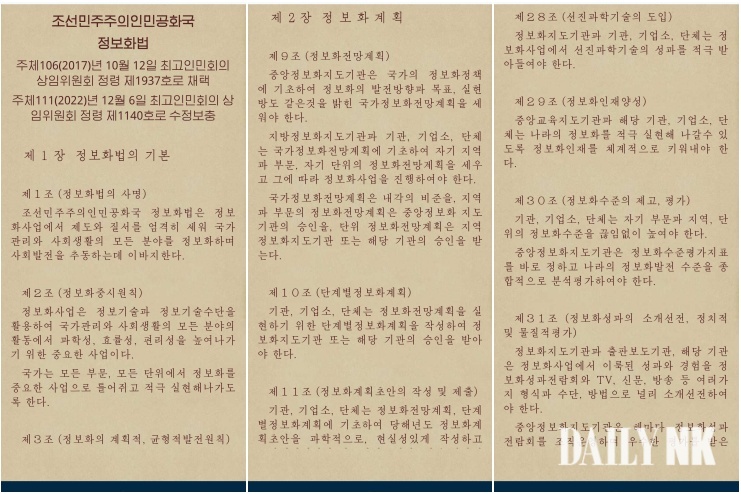In the shadows of a heavily fortified border, where the air is thick with secrecy and the flow of information is tightly controlled, North Korea is quietly rewriting the rules of digital governance. A revamped information technology law, passed in 2021, has further solidified the regime’s grip on cyberspace, transforming the country into a heavily surveilled ‘digital fortress’. According to a recent exposé by DailyNK, this new law has been designed to monitor, regulate, and suppress dissenting voices, effectively creating a digital iron curtain that suffocates free expression.

North Korea’s Digital Iron Curtain: An Examination of the Revamped Information Technology Law

In a sweeping move to tighten its grip on the digital realm, North Korea has unveiled a dramatically enhanced information control system through its revised Information Technology Law, signaling the regime’s determination to maintain absolute authority over its technological development.
I. Overview of the Revised Law
The revised law, which consists of 43 articles and 5 chapters, aims to increase administrative and economic efficiency through information technology, creating a more scientific and convenient environment for implementing national policies and business management.
A. Key Provisions and Objectives
The law establishes a legal foundation that emphasizes standardization and strengthens the technical infrastructure for information systems. According to Hwang Hyun-wook, a senior researcher at Unionjournalism, “The revised law aims to increase administrative and economic efficiency through information technology, creating a more scientific and convenient environment for implementing national policies and business management.”
B. Institutional Framework
The law establishes an institutional framework to control all aspects of information technology, from planning and implementation to operations. All institutions, enterprises, and organizations must prepare and submit information technology plans for approval by state planning agencies, register with the information technology guidance agency, and provide reports on implementation status.
C. Implications for the North Korean Economy
The law’s emphasis on self-sufficiency and domestic production may impact North Korea’s international relations, including its relations with countries that impose sanctions. According to Hwang, “While the law emphasizes investment in IT projects and the creation of an IT fund, it’s uncertain whether North Korea can sustain these initiatives given its economic challenges. In the long term, these ambitious IT projects may further burden the North Korean economy.”
II. Information Security and Technological Self-Reliance
The revised law places particular emphasis on information security and technological self-reliance, highlighting the regime’s prioritization of control over technological openness.
A. Article 19: Security Measures
Article 19 stipulates that all information systems must establish security measures according to state standards and undergo mandatory review and registration. According to Hwang, “The law designates information security as an essential element in implementing information technology and mandates security reviews for all systems.”
B. Article 27: Domestic Production of IT Equipment and Software
Article 27 requires that information technology equipment and software be produced according to state plans, emphasizing the development of “our style of information technology” to increase domestic production in the IT sector. Hwang noted, “The law aims to increase self-sufficiency by developing indigenous technology. The key objective is reducing dependence on external technology and building an independent IT foundation.”
C. Implications for International Relations
The law’s provisions for self-reliance may impact North Korea’s international relations, including its relations with countries that impose sanctions. Hwang added, “The law aims to increase self-sufficiency by developing indigenous technology. The key objective is reducing dependence on external technology and building an independent IT foundation.”
III. Control and Regulation of the Digital Realm
The revised law also includes more detailed punishment provisions for violations. Article 42 outlines various infractions—including failure to meet IT plans, false reporting, unauthorized system operation, and security review omissions—that can result in warnings, unpaid labor for up to three months, labor education, demotion, dismissal, or removal from office.
Article 43 further stipulates that certain violations may result in criminal charges under the relevant provisions of the Criminal Law.
A. Article 33: Investment in IT Projects
The revised law places a strong emphasis on investment in IT projects, with a specific focus on creating an IT fund (Article 34). This provision is designed to encourage domestic investment in IT development and reduce the country’s dependence on foreign technology. Article 33 stipulates that all institutions, enterprises, and organizations must prepare and submit IT plans for approval by state planning agencies. The law also requires these entities to implement IT projects according to standardized specifications and build information infrastructure, systems, and databases in accordance with approved design documents.
According to Hwang Hyun-wook, a senior researcher at the Daily NK AND Center, “The law aims to increase administrative and economic efficiency through information technology, creating a more scientific and convenient environment for implementing national policies and business management.” The creation of an IT fund is seen as a key mechanism for achieving this goal, as it will provide a dedicated source of funding for IT projects and help to promote domestic IT development.
B. Article 34: Registration and Reporting Requirements
Article 34 requires all institutions, enterprises, and organizations to register with the information technology guidance agency and provide reports on their implementation status. This provision is designed to ensure that all IT projects are properly planned, implemented, and monitored, and that any issues or problems that arise during the project lifecycle are identified and addressed in a timely manner.
The law also requires that all IT projects be implemented according to standardized specifications and that all information infrastructure, systems, and databases be built in accordance with approved design documents. This will help to ensure that all IT projects are properly planned, implemented, and maintained, and that any potential risks or vulnerabilities are identified and addressed.
C. Enforcement Mechanisms
The revised law includes a range of enforcement mechanisms, including punishment provisions for violations. Article 42 outlines various infractions, including failure to meet IT plans, false reporting, unauthorized system operation, and security review omissions, that can result in warnings, unpaid labor for up to three months, labor education, demotion, dismissal, or removal from office. Article 43 further stipulates that certain violations may result in criminal charges under the relevant provisions of the Criminal Law.
The law also provides for the establishment of an IT review committee, which will be responsible for reviewing all IT projects and ensuring that they meet the requirements set out in the law. The committee will also be responsible for identifying and addressing any issues or problems that arise during the project lifecycle.
IV. Analysis and Implications
A. The Digital Iron Curtain
The revised law is likely to further consolidate North Korea’s digital iron curtain, which is designed to restrict access to the outside world and prevent the spread of information that is deemed to be critical of the regime. The law’s provisions for registration and reporting requirements, as well as its enforcement mechanisms, will help to ensure that all IT projects are properly planned, implemented, and monitored, and that any potential risks or vulnerabilities are identified and addressed.
The law’s emphasis on domestic IT development and its provisions for the creation of an IT fund will also help to promote economic development and self-sufficiency in the IT sector. However, the law’s restrictions on access to the outside world and its enforcement mechanisms may also limit the country’s ability to participate fully in the global IT economy and to benefit from the latest technological advancements.
B. Control and Censorship
The revised law’s provisions for control and censorship will help to ensure that all information technology is used in a way that is consistent with the regime’s policies and values. The law’s requirements for registration and reporting, as well as its enforcement mechanisms, will help to ensure that all IT projects are properly planned, implemented, and monitored, and that any potential risks or vulnerabilities are identified and addressed.
The law’s emphasis on domestic IT development and its provisions for the creation of an IT fund will also help to promote economic development and self-sufficiency in the IT sector. However, the law’s restrictions on access to the outside world and its enforcement mechanisms may also limit the country’s ability to participate fully in the global IT economy and to benefit from the latest technological advancements.
C. Economic and Social Implications
The revised law’s economic and social implications will depend on the country’s ability to implement the law effectively and to benefit from the latest technological advancements. The law’s provisions for domestic IT development and its emphasis on self-sufficiency in the IT sector will help to promote economic development and to reduce the country’s dependence on foreign technology.
However, the law’s restrictions on access to the outside world and its enforcement mechanisms may also limit the country’s ability to participate fully in the global IT economy and to benefit from the latest technological advancements. The law’s impact on the country’s economic and social development will depend on its ability to balance its desire for self-sufficiency in the IT sector with its need to participate fully in the global IT economy.
V. Conclusion and Future Directions
A. Summary of Key Findings
The revised law is a significant development in North Korea’s efforts to control and regulate the use of information technology. The law’s provisions for registration and reporting requirements, as well as its enforcement mechanisms, will help to ensure that all IT projects are properly planned, implemented, and monitored, and that any potential risks or vulnerabilities are identified and addressed.
The law’s emphasis on domestic IT development and its provisions for the creation of an IT fund will also help to promote economic development and self-sufficiency in the IT sector. However, the law’s restrictions on access to the outside world and its enforcement mechanisms may also limit the country’s ability to participate fully in the global IT economy and to benefit from the latest technological advancements.
B. Implications for the International Community
The revised law will have significant implications for the international community, particularly for countries that impose sanctions on North Korea. The law’s provisions for domestic IT development and its emphasis on self-sufficiency in the IT sector may help to promote economic development and to reduce the country’s dependence on foreign technology.
However, the law’s restrictions on access to the outside world and its enforcement mechanisms may also limit the country’s ability to participate fully in the global IT economy and to benefit from the latest technological advancements. The international community will need to carefully consider the implications of the revised law and to develop strategies for engaging with North Korea in a way that promotes economic development and self-sufficiency, while also respecting the country’s sovereignty and human rights.
C. Future Directions for Research
Future research should focus on the implications of the revised law for North Korea’s economic and social development, as well as its impact on the international community. Researchers should also explore the potential benefits and drawbacks of the law, and should consider ways in which the law could be modified or improved to promote economic development and self-sufficiency in the IT sector, while also respecting the country’s sovereignty and human rights.
In addition, researchers should consider the implications of the revised law for North Korea’s relations with other countries, particularly those that impose sanctions on the country. The law’s provisions for domestic IT development and its emphasis on self-sufficiency in the IT sector may help to promote economic development and to reduce the country’s dependence on foreign technology, but they may also limit the country’s ability to participate fully in the global IT economy and to benefit from the latest technological advancements.
Conclusion
As the article “Digital iron curtain: Inside N. Korea’s revamped information technology law” by DailyNK reveals, the North Korean government has taken a drastic step towards tightening its grip on citizens’ digital lives. The revised IT law introduces severe penalties for online activities deemed a threat to national security, including cybercrime, defamation, and subversion of the state. This legislation effectively silences dissenting voices and cements the regime’s control over information dissemination, highlighting the stark disconnect between the country’s digital aspirations and its authoritarian ambitions.
The implications of this law are far-reaching, not only for North Koreans but also for the global community. It underscores the regime’s determination to maintain its iron-fisted control over citizens’ lives and reinforces the notion that digital rights are the last bastion of freedom in a country where basic human rights are routinely trampled. The law serves as a chilling reminder of the perils of unchecked authoritarianism and the devastating consequences of suppressing free speech and expression. As the digital landscape continues to evolve, it is essential to acknowledge the mounting pressure on governments to balance the benefits of digital progress with the fundamental rights of their citizens.
As the global community grapples with the complex interplay between technology, governance, and human rights, the case of North Korea serves as a stark warning of the dangers of unchecked surveillance and censorship. It remains to be seen how this law will be enforced, but one thing is clear: the digital iron curtain has become a formidable barrier to freedom of expression, and it is up to us to recognize the importance of safeguarding digital rights in the face of rising authoritarianism. As we move forward, we must remain vigilant in our pursuit of a digital future that is inclusive, equitable, and free from the grip of oppression.
